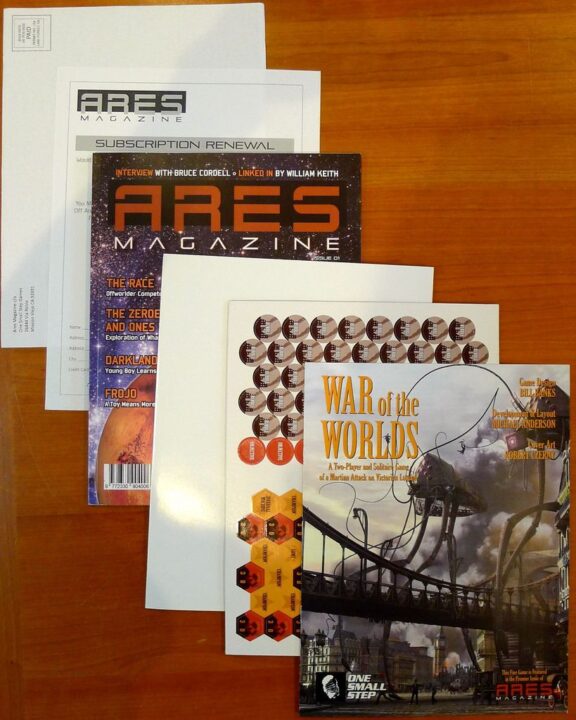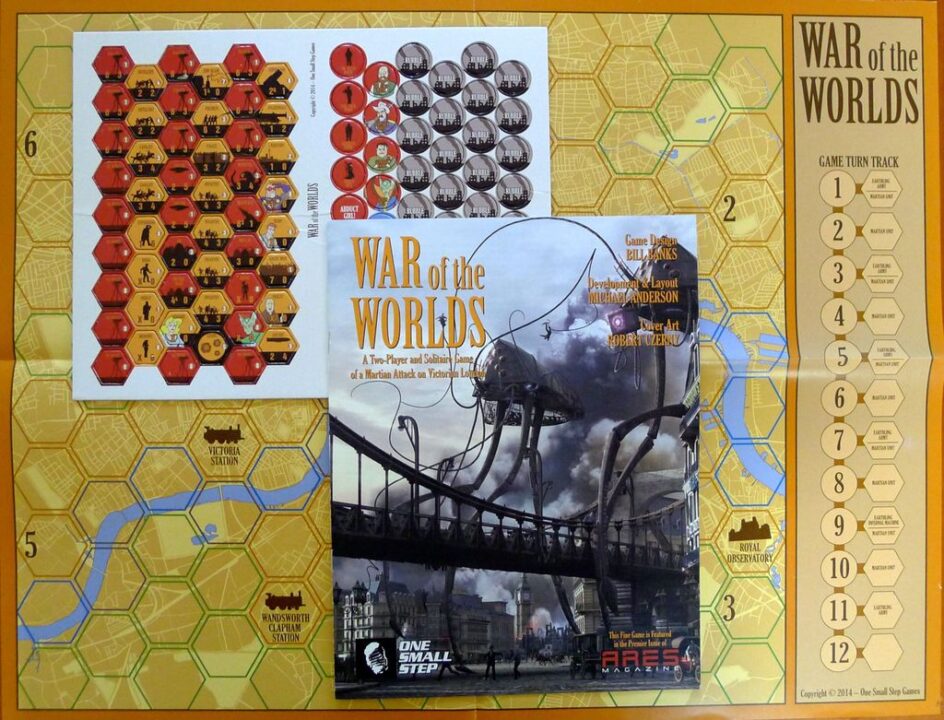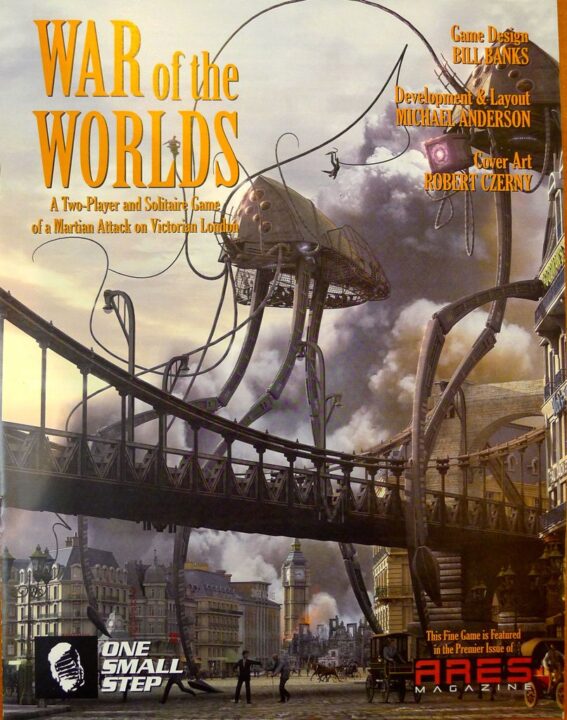Ever wondered what it’s like to battle Martians for Earth’s survival? Well, get ready because we’re reviewing War of the Worlds, a game that pits humans against invaders in a thrilling standoff. This game is packed with unique mechanics, from asymmetric warfare to deck-building, and offers a high level of replayability. But it’s not all sunshine and rainbows; we’ll also talk about some balance issues and complexity that might make you think twice. Grab your game night crew, and let’s get into it!
How It Plays
War of the Worlds is an asymmetric deck-building game for two players. One side plays the Martians, the other plays the humans. Let’s break it down!
Setting up
First, place the board between both players. Then, each player picks their faction and takes their respective deck and components. Shuffle your deck and draw a hand of five cards. Place the starting units on the board as indicated in the rulebook. You’re set and ready to go!
Gameplay
The game turns are simple but strategic. On your turn, you can play cards from your hand to move units, attack, and gain resources. Each card has unique abilities that help you develop your strategy. During your turn, you can also purchase new cards to add to your deck, making it stronger. The Martian player deploys advanced technology and brute force, while the human player relies on guerrilla tactics and resource management. Each side has unique strengths and weaknesses, making every match a new experience.
Winning the game
To win the game, the human player must destroy the Martian base, while the Martian player wins by wiping out human resistance. Simple, right? But with all the strategic options, how you get there will be anything but straightforward!
Want to know more? Read our extensive strategy guide for War of the Worlds.
Exploring Gameplay Mechanics in War of the Worlds
If you love strategy games with a twist, War of the Worlds won’t disappoint. This board game throws you into the heart of an alien invasion. I remember one game night when I found myself stuck between a rock and a Martian tripod! The game is all about asymmetric warfare, where one player controls the alien invaders and the other, the human resistance. This dichotomy keeps things fresh and exciting.
What’s really cool is the deck-building mechanism. Each player starts with a basic deck but can upgrade by purchasing more powerful cards as the game progresses. This adds a strategic layer that forces you to think long-term while making immediate, tactical decisions. It’s like playing chess but with more lasers and less boredom!
One downside, though, is the game balance. The aliens usually start strong, while the humans have a bit of a rocky start. My buddy Mike, after playing the human side for the fifth time, swore he’d quit if he had to do it again. The imbalance means sometimes it feels like luck more than skill determines the winner.
Resource management is also a big part of the game. You need to collect energy and materials to fuel your efforts. This can be a double-edged sword. Run out of resources, and you’ll feel like you’re crawling through molasses. But get it right, and hitting your stride feels incredibly rewarding.
Next, we’ll get into the game’s theme and artwork. Trust me, you won’t want to miss that!

Theme and Artwork of War of the Worlds
Oh boy, if there’s one thing War of the Worlds nails, it’s the theme and artwork. The game draws you into its universe like a fine-tuned black hole. Remember H.G. Wells’ classic tale of Martian invasion? The designers sure did. This game is dripping with atmosphere.
The Martians are not your friendly neighborhood visitors. The artwork makes that clear. The alien designs are both creepy and cool, a bit like my Uncle Larry after too many root beers. The human forces, trying to fend off these unwelcome guests, don’t look half bad either. There’s a gritty realism to the human side, contrasting sharply with the high-tech alien menace. It’s like pitting a rusty pickup truck against the latest Tesla – but with lasers!
Now, let’s talk about the board itself. It’s a stunner. The city maps are cluttered with destruction, chaos, and landmarks. It feels like you’re moving pieces around in a post-apocalyptic world. The muted colors and intense detail make it immersive, as if the Martians are going to pop out from the board and demand your surrender any second now.
Cards? Oh, they got those, too. Each card is a mini work of art. They help to tell a story while you strategize your next move. And the player mats? Functional and eye-catching. You’ll spend half the game admiring them and the other half trying not to mess them up with your Cheeto fingers.
Next up: Player interaction in War of the Worlds. Spoiler alert: You’ll want to phone home about this!

Player Interaction in War of the Worlds
Oh boy, where do I even start with player interaction in War of the Worlds? This game is hot! Imagine a dance-off, but instead of groovy moves, you’ve got humans and aliens throwing down with deadly force. The game features asymmetric warfare, which makes the interactions between the players incredibly intense. You’re not just playing a game; you’re engaging in an epic standoff where every decision could swing the tide of battle.
One of the coolest things about War of the Worlds is how it forces you to think two steps ahead. You can’t just play your cards willy-nilly. Every move you make has to counter what your opponent is doing. For instance, if you’re the human player, you might focus on gathering resources and rebuilding your defenses. Meanwhile, the alien player is sending out devastating attacks and trying to corner you. It’s a constant back-and-forth, a tug-of-war that keeps you on your toes.
The interactions don’t stop there. Each player has unique abilities and strategies they can employ. Humans can sabotage alien tech or fortify cities, while aliens can deploy powerful weapons and manipulate the environment. The dynamic is rich, and as you can imagine, it gets pretty heated around the table.
I remember one game night where my buddy Mike and I had a standoff that lasted for ages. He was the human player, and I was the alien menace. We were both down to our last cards, and it felt like the universe was holding its breath. It’s this kind of interaction that makes War of the Worlds unforgettable.
Next up, let’s look at the replayability of War of the Worlds. Spoiler: You might want to shuffle up and deal again!

Replayability in War of the Worlds
When it comes to replayability, War of the Worlds offers a mixed bag. First off, the game features different factions with unique abilities. Whether you’re leading the human resistance or commanding alien invaders, each side brings distinct strategic elements. This makes each session feel fresh and challenging. Switching factions also changes the dynamic.
The game includes a variety of cards, events, and tactical options, which adds layers of depth. Customizing your deck and refining your strategy keeps you engaged. But, beware! Some cards can feel more powerful than others. This can lead to unbalanced games.
Moreover, the modular board is a fantastic feature. The board can be reconfigured to create new battlegrounds. This opens up different tactical avenues in each playthrough. No two games will be exactly the same, which amps up the excitement.
But let’s talk about the elephant in the room. The game requires a lot of setup time. Setting up takes a while, which can be a drag. Then there’s the learning curve. The rules aren’t beginner-friendly, so newbies may feel overwhelmed. You might spend more time explaining the game than actually playing it.
Despite these quirks, the game’s high replayability is a significant plus. If you’re someone who enjoys strategy and doesn’t mind the setup, this game offers countless hours of thrilling gameplay.
Do I recommend War of the Worlds? Absolutely, but with a caveat. It’s a great game for strategy lovers, but be prepared for the setup and rules complexity!
Conclusion
War of the Worlds offers a thrilling experience with its asymmetric warfare, unique strategies, and high replayability. The theme and artwork immerse you in a tense human vs alien showdown. However, it has some balance issues and setup complexity. If you love strategic games and don’t mind a bit of a learning curve, you’ll have a blast with this one. This concludes my review. Grab your copy, and may the best species win!

